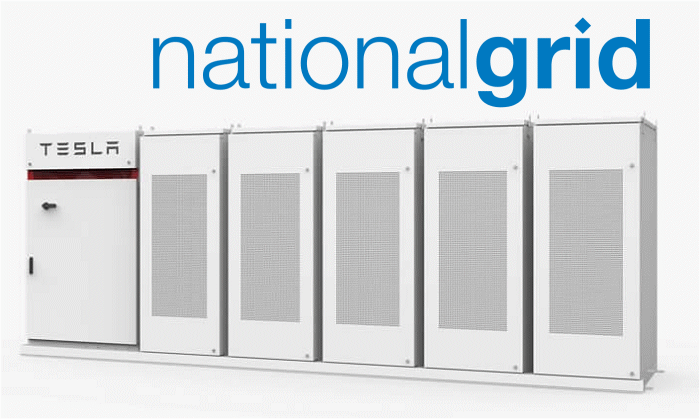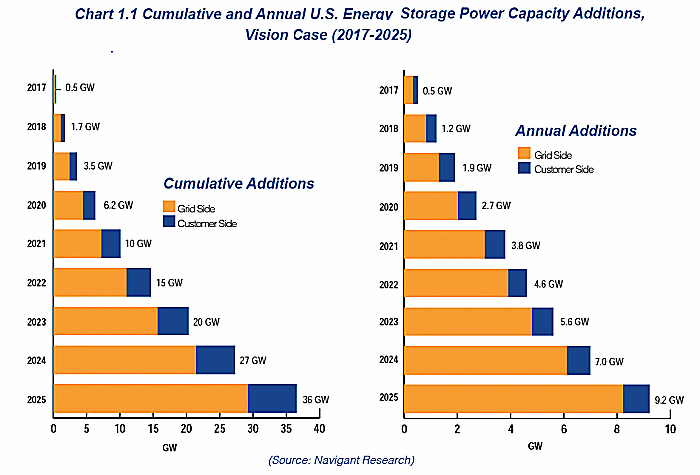National Grid has announced a 48 megawatt-hour battery energy storage system will be installed by Tesla on the island of Nantucket.
Nantucket is situated approximately 50 kilometres by ferry south from Cape Cod, in the U.S. state of Massachusetts. Electricity is transmitted to the island via a pair of submarine cables.
In the situation of one of the submarine cables failing, two six-megawatt diesel generators can kick in to provide partial back-up power – but those generators are reaching the end of their service life. The new battery system will avoid the need for one new diesel generator and also delay the construction of an additional submarine cable for 15 to 20 years beyond the current 12-year forecast.
The Tesla Powerpack based battery energy storage system (BESS) will be six megawatts, with an eight-hour duration. Tesla’s Powerpack is also being used for a 100MW/129MWh project at the Hornsdale Wind Farm near Jamestown in South Australia.
Nantucket is a popular tourist destination and home to nearly 11,000 people. Residents of the island consistently pay some of the highest prices in the United States for electricity – and energy demand is growing.
National Grid, the island’s only electricity utility, had previously determined Nantucket’s electricity demand was increasing more than five times the Massachusetts state average.
“The BESS provides a very efficient and effective solution to two major energy challenges facing the island,” said National Grid’s Rudy Wynter. “Our customers, communities, and policymakers look to us to deliver innovative solutions like this to help advance our clean energy future.”
A U.S. Vision for Energy Storage
In related news, the Energy Storage Association (ESA) has published a white paper mapping a path to 35 gigawatts of new energy storage systems installed in the U.S. by 2025.
The report says attaining that level would result in a disruption-proof and resilient grid, USD $4 billion in cumulative operational grid savings and the potential for more than 167,000 new jobs.
Currently, the U.S. has approximately 0.5 GW of installed energy storage capacity across retail and wholesale markets.
“The deployment of 35 GW of new energy storage by 2025 will fundamentally transform how we generate, deliver and consume energy, lowering costs and improving air quality and emissions for every user of the grid,” said Praveen Kathpal, vice president of AES Energy Storage and chairman of the board of directors at ESA.
The white paper, titled “35×25: A Vision for Energy Storage”, can be downloaded here (PDF).



 RSS - Posts
RSS - Posts



An interesting aspect to the part of the above article (perhaps, the part should have been split off, as a separate article?) with the title “A U.S. Vision for Energy Storage”, is the information
”
In related news, the Energy Storage Association (ESA) has published a white paper mapping a path to 35 gigawatts of new energy storage systems installed in the U.S. by 2025.
The report says attaining that level would result in a disruption-proof and resilient grid, USD $4 billion in cumulative operational grid savings and the potential for more than 167,000 new jobs.
”
Thus, for the USA to achieve “a disruption-proof and resilient grid”, 35GW of energy storage is apparently, believed to be required.
At
https://en.wikipedia.org/wiki/List_of_countries_and_dependencies_by_population
the USA is shown to have a current estimated population of 326,071,000; about 326 million.
Using the current estimated population number (rather than a projected population estimate as at 2025), that gives, I believe, about (3.5 x 10 EXP10)/(3.26 x 10EXP06) -> approximately 107Wh per person, of battery storage, to achieve “a disruption-proof and resilient grid”.
At
https://en.wikipedia.org/wiki/List_of_countries_and_dependencies_by_population
Australia is shown as having an estimated current population of 24,709,200 (about the same as the Ivory Coast, and, slightly less than North Korea).
Using the same factor as for the USA, of approximately 107Wh per person, means that Australia, for the whole of the country, would require about 107 x 24,709,200 -> about 2.65GWh of battery storage, to achieve “a disruption-proof and resilient grid”.
And, as WA is not part of the infamous NEM, and, as WA has about 1/10 of the population of Australia, WA would need about 265MWh of battery storage, to achieve “a disruption-proof and resilient grid”.
At
http://www.population.net.au/population-of-south-australia/
is
”
South Australia has population of over 1.7 million, which accounts for 7.14% of Australia population.
”
So, using 7.14 as the percentage of Australia’s population, gives a requirement, based on the above, of 0.714 x 265 = approximately 189MWh of battery storage, to achieve “a disruption-proof and resilient grid”.
Interesting.
And, if these two states implemented these quantities of battery storage, then the two states should surely satisfy prime minister Trumpbull’s requirements for electricity resilience.
And, if householders, with governmental assistance , and, permission, could install battery storage totalling these quantities, we would achieve”a disruption-proof and resilient electricity supply”.
Hmm.
(Note: I stand to be corrected, on any of my calculations or source quantities)
Apology – in my calculations above, where I have
” (3.5 x 10 EXP10)/(3.26 x 10EXP06)”
I believe that should instead, be
” (3.5 x 10 EXP10)/(3.26 x 10EXP08)”
but I believe that the results are the same.
Average rooftop solar output in Nantucket is the same as in Melbourne, which is better than I expected. While not a lot by Australian standards, it still gives them the option of producing plenty of electricity from roofs.